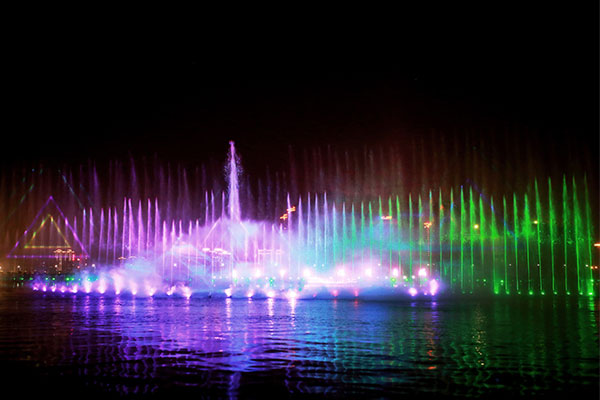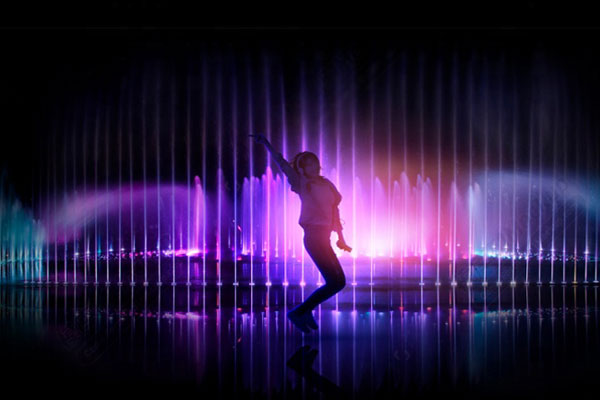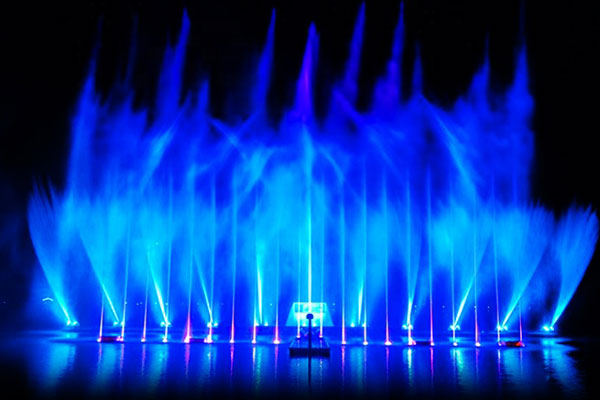29 May 2020
1.Modeling design and nozzle selection
There are several types of musical fountain ,such as still water, running water, falling water, and water spray. These forms can also derive a variety of colorful changes, especially due to the development of nozzle technology, the spraying posture has changed a lot. With these materials, through professional art design, you can sketch a beautiful aquatic landscape.
In addition, different music fountain forms are suitable for different application scenarios. For example, musical fountains are generally suitable for meeting places such as squares. It is an organic combination of music, water shape, and light to give people a visual and auditory beauty; at the same time, the fountain and the square are integrated into one, forming part of the building. The buildings in the residential area are more suitable for the design of the stream surrounding to reflect the quiet and leisurely atmosphere, giving people a smooth and relaxing visual enjoyment, thereby creating a pleasant living rest space.
The choice of nozzles in fountain design is very important. Various types of sprinklers are widely used in waterscapes to generate various water shapes. At present, there are great differences in the quality of domestically produced nozzles. Compared with similar products abroad, the biggest problem is not only the appearance but also the design quality. For example, the use parameters of a nozzle provided by a manufacturer are far from the actual operating values. The biggest requirement of the water landscape project for the sprinkler is that the water shape is beautiful and the jet is smooth and stable. However, the jet of most domestic products is either strongly divergent or shaved; even if it is the same batch of products, the water quality is also very unstable. Except for the reason that the domestic nozzles have insufficient machining precision due to small-scale production, the fundamental problem is There is no perfect design theory and design basis in the design of landscape-specific nozzles. Therefore, we recommend that the National Professional Society organize relevant experts to formulate practical design specifications and standards as soon as possible, so that the water fountain industry in China can be further developed in a more standardized manner.
In actual use, attention should be paid to the characteristics of various nozzles. Generally, the wind resistance of the water film nozzle is poor, so it is not suitable for outdoor use in windy places; while the jet suction nozzles such as cedar or springs are more sensitive to water level changes, not only should pay attention to water level changes when using, but also in the pool There are corresponding measures to suppress waves. Such as the installation of a long overflow weir or underwater wave wall. However, it is also conducive to the construction of a pulsating fountain, which is a hydraulic phenomenon of wave resonance. The regular wave surge makes the water jet jump regularly and changes in height. At present, there are many high-tech fountain equipment, which can also be used in aquatic landscapes. The jets of Bright Spring and Jumping Spring are very smooth and stable, and the appearance is like a glass rod, which can accurately fall in the water hole; Jumping Spring can generate a water jet of variable length under the control of a computer; the jumping ball fountain can spray a controllable size Smooth water polo. They are very interesting and unforgettable. Various high-tech nozzles used in large-scale music fountains and various high-tech nozzles used in underwater musical fountains and underwater motion machinery and control parts are also in a wide variety and can be widely selected.

2.Civil engineering pool design
Generally, the depth of common landscape pools is 0.6-0.8m. The reason for this is to ensure the submerged depth of the water inlet, and the bottom of the pool is an overall plane, which is also convenient for the installation and maintenance of the pipeline equipment in the pool. The suction pit or pump pit is used only when it is designed for a shallow butterfly-shaped pond body that reflects hydrophilic characteristics. The water depth of 0.6-0.8m actually has a great unsafety. Similarly, in the design of children's paddling pool, the depth generally adopted is about 0.3 ~ 0.6m. Once the child falls into the landscape pool, it will be very dangerous. We think the more suitable water depth is 0.2 ~ 0.4m. Another advantage of this is that when the turbidity of the water is slightly higher, the impression is still clear. The top surface of the pool wall should be available for visitors to sit down and rest. The height of the top surface of the pool wall from the ground is generally 0.30 to 0.45m. In addition to the artificial lake, the water surface should be higher than the ground. If the water level is low, you will feel like you are in a deep pool. From a hydrophilic point of view, a more suitable scale is that the water surface is 0.2m away from the top of the pool wall, which is more reasonable. Submersible pump pits or water pump suction ports only need to be locally deepened to meet water suction conditions. Grate can be provided on the surface of the pump pit, which can be used as a shielding device and as a grill to prevent large particles from being sucked in. From an aesthetic point of view, the exposed surface of the pool should be minimized, especially the vertical overflow nozzle, which will produce a large drainage suction sound when the water surface rises.
3.Pipe material selection
Earlier projects generally used hot-dip galvanized steel pipes, but there were many shortcomings. After being used for a period of time, the surface of the steel pipe is corroded, which affects the appearance, and the service life is more than double that of the concrete structure. The better pipes are copper pipes and stainless steel pipes, but the cost is higher. UPVC pipe can avoid corrosion, but it has poor weather resistance, and direct light irradiation accelerates discoloration and aging. If it is buried under the bottom of the pool (in the north, pay attention to the slope and the vent valve at the lower end, and drain and freeze in winter), and the use of copper or stainless steel pipes in the exposed part should be a more reasonable and economic solution. According to the manufacturer, the service life of UPVC pipes can reach fifty years without direct sunlight.
4.Selection of pump type
At present, in order to save construction area or reduce project cost, many waterscape projects use submersible pumps that do not require a pump room as hydraulic lifting equipment. However, the reliability of China (including some submersible pumps abroad) is much lower than that of dry centrifugal pumps. As a result of the damage of individual submersible pumps, one is that the waterscape often has local defects and incomplete shapes; the second is that once the insulation of the pump is damaged, the water body will be electrified, and there have been several incidents of casualties due to leakage of the landscape submersible pump in China. If a centrifugal pump is used, the length of the pipeline is increased, and a pump room is required, which greatly increases the cost of water landscape. Therefore, the development of high reliability submersible pumps is a key to reducing the cost of water feature projects. In terms of maintenance conditions, centrifugal pumps also have advantages that submersible pumps cannot match. To maintain long-term reliable operation of the water landscape, we believe that centrifugal pumps should be preferred. (When using a centrifugal pump, a leakage protection switch must be installed. At the same time, the pump should be set up for reliable and repeated grounding. At the same time, the steel mesh of the tank body should be equipotential grounded.
5.Lighting and electrical design
Underwater lighting fixtures are commonly used equipment in waterscapes, especially in fountains. At present, Philips underwater lights with plastic brackets are mostly used in China, which have many problems. For example, the structural strength is poor, it is easy to be damaged when the water in the fountain pool fluctuates strongly or is affected by other external forces, the reliability of the sealing design of the lamps and lanterns is poor, and the plastic ages rapidly under the sun. Once the lamp is damaged or the seal fails, it will leak electricity and make the water body electrified, which becomes the biggest hidden danger of waterscape safety. In particular, the design of the current general waterscape fountains are all handled by professional fountain manufacturers. In addition, the national standards are not very sound in waterscapes, and there are many loopholes in security precautions. Therefore, the domestic design and construction codes should conduct detailed research on the safety of waterscape electricity consumption, and formulate strict and feasible codes to ensure personal safety. The author believes that in a water scene without isolation, easy access or strong participation, a safety voltage of 12 volts must be used in accordance with the swimming pool electricity design specifications. The lamp body should be completely shielded in the lamp housing with higher strength, and the lamp housing should be reliable Connect the pool and the installation position of the lamps and lanterns should also consider using pipeline sprinklers and other objects to protect them. If the transmission distance is far away, the method of increasing the output voltage should be adopted to compensate the voltage drop loss of the cable. The insulation between the high and low voltage windings of the transformer should be ensured. It is best to separate the primary and secondary, and the core of the transformer should also be grounded. When the installation power of the luminaire is very large, consider setting up a transformer near the waterscape. When high-pressure lamps such as metal halide lamps must be used for special needs, isolation transformers must also be used, regardless of the circumstances Leakage protection switches must be used to ensure personal safety.

6.Water level control
The control of water level and water level is sometimes extremely important. For example, jet suction nozzles such as cedar nozzles and springs are very sensitive to changes in water level. When the water level rises and falls slightly, the height of the fountain and the shape of the water will change greatly. To this end, there should be a reliable automatic water replenishment device and an overflow pipeline. It is better to use an independent water level balancing tank and a hydraulic water level control valve, and use a connecting pipe of sufficient diameter to connect with the waterscape pool. If it is placed outdoors, the water level balancing well should be camouflaged. For example, if the shape is made of large tree roots or artificial rock mountains, the problem of antifreeze should also be fully considered in the northern area. The overflow pipeline should be set in the water level balance well. Since the balance well is generally capped, it can also shield the overflow and make-up noise.
7.Water source and water quality control
At present, most of the water sources used for waterscapes are tap water, and a few use clean natural water or groundwater as water sources. China is a water-scarce country. Most cities use water tightly. How to save water resources and maintain landscape water quality is becoming an increasingly important issue. The more common trend in the industry is to adopt reclaimed water as the water source of water landscape. The author thinks that this method should be vigorously promoted, but further research should be done on the technology to improve the implementation process.
Landscape water quality must first be clear, colorless and odorless. If the water landscape is not guaranteed by good water quality, there is no beauty. For this reason, in areas with normal sunshine in summer, water needs to be cleaned once every 7 to 15 days. The first reason is that the turbidity is increased by falling dust, and more importantly, because the growth of algae affects the perception of turbidity and color, to the extent that the senses are unacceptable.
Research shows that when the total phosphorus concentration in water exceeds 0.015mg / l and the nitrogen concentration exceeds 0.3mg / l, algae will multiply in large quantities, thus becoming the primary cause of deterioration of water quality. The effective method to suppress algae is generally to add copper sulfate to the water, but the effect is not significant. The fundamental solution to the problem is still how to remove N and P. The author believes that by using high-quality miscellaneous drainage as the water source, after a relatively perfect treatment of reclaimed water, the treatment process should be increased to reduce the concentration of N and P in the water, which can solve this problem.
For the control of algae, we can focus on removing phosphorus in water. Methods for removing P include biological methods, oxidation methods, chemical precipitation methods, and physical film processing methods. Among them, the lowest investment and operating cost is the biological method, but it is generally impossible to build a biological treatment structure beside the water feature. Owing to the smell of biological treatment, it is also difficult to manage. The chemical precipitation method is more realistic. The principle of this method is to add metal ions to the water to form a precipitate with phosphate to remove phosphorus. The more commonly used agents are lime, alum, polyaluminum and ferrous sulfate. Since iron salt will increase the color of water, aluminum salt is better. Theoretically, 1 mol of phosphate can be precipitated for every 100 mol of aluminum salt input, and micro-flocculants are generated by the flocculation of aluminum salts, and then the flocs are filtered out. The coagulation process can be combined with the conventional water circulation filtration system of the water landscape. After the water change, the system mainly removes phosphorus, and when the phosphorus concentration drops, it mainly removes turbidity. This can greatly extend the use time of the water body, so as to achieve the purpose of saving water.

Keywords: musical fountain
Originally published 29 May 2020, updated 29 May 2020.